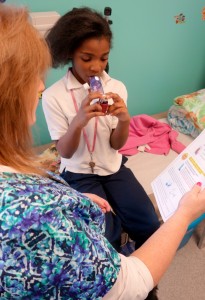How Henry Ford’s Innovative Pharmacy Program Reduces Asthma
A pre-teen girl with a history of asthma came into the school clinic for an initial evaluation. After listening to her chest and hearing nothing, the doctor checked his stethoscope and tried again. Still no sound. “Are you feeling alright?” he asked. “Yes,” she said.
She sat there like any other child, without any sign of distress. Her body had learned to compensate over time and she no longer knew what it was like, nor was she able, to take a full and healthy deep breath. After two back-to-back breathing treatments of albuterol and a dose of oral steroids, the doctor listened again and this time heard breath sounds. “I can feel the difference,” she said. A short course of oral steroids was prescribed, along with an albuterol inhaler, a spacer and a controller medication. She was also given an asthma action plan and was scheduled to return for a follow-up visit the next week.
At the follow-up visit it was as if the doctor was listening to her lungs for the first time. Again, no breath sounds. “Did you take your medications?” the doctor asked. “No. We don’t have a car, so we couldn’t get to the pharmacy,” she explained.
Does this story sound familiar to you? It plays out all too often in school-based health centers across Michigan. “Sadly, due to multiple barriers, including a shortage of providers and limited transportation, most children in Detroit who suffer from asthma are not receiving adequate treatment and lack the necessary medications to keep their asthma under control,” said Dr. Attisha. It was the first of many times that Dr. Elliott Attisha, Medical Director for Henry Ford Health System’s pediatric mobile clinic program, saw first-hand the barriers to good asthma self-management. Eventually, the repeat stories led to the creation of their medication delivery program, a program made possible thanks to a partnership with Henry Ford Health System’s Ambulatory Pharmacy. The delivery program quickly spread to all sites within Henry Ford’s School-Based and Community Health Program (SBCHP), which in addition to two mobile clinics also features seven school-based health centers. At Henry Ford’s SBCHP, taking care of kids with asthma is a priority. The delivery program for asthma (and other) prescription medications and spacers has made a real difference. So how does it work, and could your health center do it, too?
So the first step for Henry Ford’s SBHCP is to identify children with asthma. This is done by reviewing the consent which allows for treatment at the health center. This same consent includes permission for a child to carry home medications. Once a child with asthma is identified they are then scheduled to see the provider. If needed, a prescription for medication is sent to Henry Ford’s outpatient pharmacy through their Electronic Health Record (EHR) system. The medication is billed to the patient’s insurance, and if the patient does not have insurance, the cost is covered through Henry Ford Ambulatory Pharmacy’s charity fund. On the same day, the medication is delivered to the school-based health center or mobile clinic(s) by the pharmacy, in time for an education session between the school nurse and child.
This process allows health center staff to provide the child with hands-on education on the best ways to use the medication and spacer. Though not always possible, parents are strongly encouraged to be present. An asthma action plan is also included as part of the education session. The child, and parent if present, is asked to repeat back the technique, confirming a clear grasp of the instructions. The child is brought back for follow-up based on asthma guidelines, and once the child’s asthma is under control, the refills can be switched to mail delivery.
Want to give it a try at your center? Henry Ford’s SBHCP staff offers this advice and lessons learned:
- Find a pharmacy partner. It’s ideal if the pharmacy is linked somehow to your program. If not, you can start by creating a map of the pharmacies in your area. Then visit each of them, giving information and materials about your program. Make sure the pharmacies carry the medications and spacers you commonly prescribe.
- Ask each of the pharmacies:
- Do you have staff to help with deliveries? If not, does the pharmacy have someone who can review medication use?
- Will you help us (health center staff) track refills? Tell us if a medication is not covered or requires prior authorization? Tell us if the patient fails to pick up their medication?
- What programs do you suggest to help cover medications for the uninsured?
- Make sure you order a second quick-relief inhaler to keep at school. If insurance does not allow this, then one can be ordered at the next follow-up visit. You may be able to get a second spacer, as well (up to 4 per year are covered by Medicaid plans).
- Have a go-to-person at the school who knows of all the students with asthma, whether they self-carry, where medication is kept, etc.
- Train school staff on proper use of asthma medications and spacers.
- Enlist asthma champions at the school. This could include children with asthma who are being treated by the health center.
- Make sure that the school has a completed “permission to carry form” on file.
- Talk with the family and pharmacy about refilling medications on breaks and through the summer.
- Make sure to ask about history of anaphylaxis, and ensuring child has access to an EpiPen if needed.

